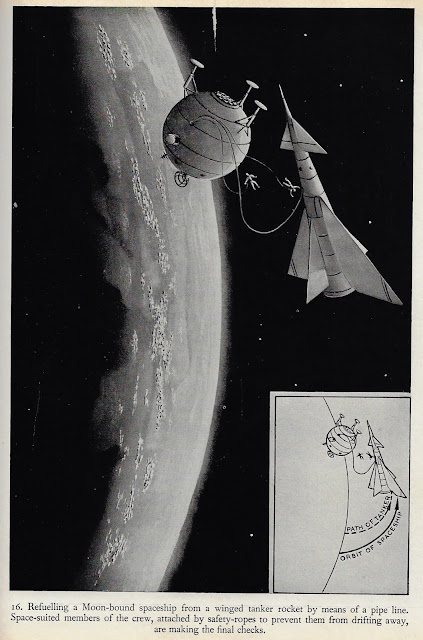First came Authentic Science Fiction as a monthly magazine of both science fiction and science fact articles. Then came a British annual for children taking advantage of the trend towards space subject in books.
Edited by H.J. Campbell ; foreword by Arthur C. Clarke. Authentic Science Fiction. London. (100 pp.),28 cm.
A amazing treasure of the early British space literature, the contents are a mixture of articles and fictional stories by science fiction writers associated with the British Interplanetary Society (B.I.S.) and the London Science Fiction Circle.
This copy was signed by one of the great American SF Collectors and occasional writer, Forrest J. Ackerman.
It has a number of interesting articles about the history of rockets, navigating rockets, a reprint of a B.I.S. paper on artificial satellites, and how to communicate with aliens. Also the usual comic strips, puzzles, and various games.
With all the strangeness going on and having to work from home I am going to go back to my favorites. So this is the first in re-scanning some books that I have shared before over the last 10 or so years. I hope these still bring you as much joy and they do me.
Arthur C. Clarke. The Young Traveler in Space. Illustrated by Edmund Blandford, G.A. Frodsham and R.A. Smith. London : Phoenix House. (72 pp.) 28 cm.
This was Arthur C. Clarke's children's book to teach about spaceflight.
It was a basic book about the history of thought about spaceflight, basic principles of rockets and a explanation how we would get to the Moon and the planets.
As the man who basically first put forward in print the idea of communication satellites, this diagram above is almost historic in showing and explaining this idea to children.
There were many ideas about what a space station would look like but it was always promoted as the first part of our "steps to the planets."
The next step was the Moon. This "vision" was based on plans developed by the British Interplanetary Society (BIS) and was illustrated by the best of the early British space artists, R.A. Smith.
This last photograph was part of the exploring the planets section. It was not clear exactly what it would look like but "space domes" were always thought to be a part of it.
So to celebrate Easter this year I have been saving this item that I bought just after Easter in 2019. Back when the earth was new there appeared coloring kits for Easter eggs. Instead of vinegar and food coloring there were "kits" that your parents would buy. In 1966 there was a space-based Chick-Chick kit designed around a U.S.A. space station and the planets.
Observe the rocket, satellites, space station and descending space capsule on the side of the box.
The key to this "space shot" was the space station platform you could build to hold your decorated eggs.
The platform and the space station had punchouts with facts about the planets.
Alas poor Pluto was left out again from the list of planets (a premonition of the future?)
It also came with two coloring books, that you could color and enter a contest. The first (above) was rather generic, the second was this one:
You could win a bicycle if you could color imaginatively enough!
Happy Easter to you all.





























